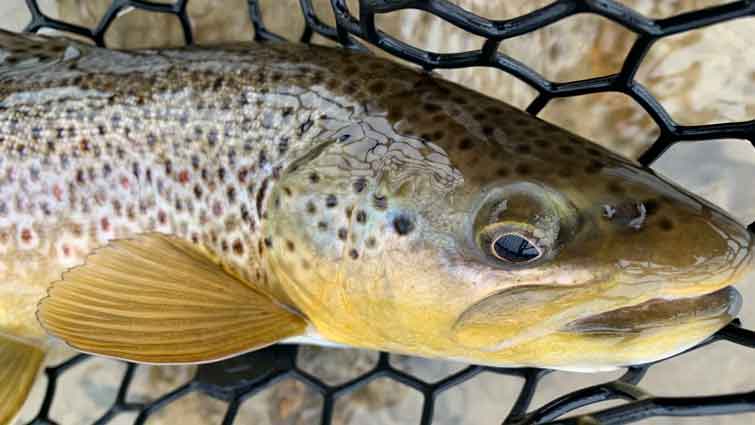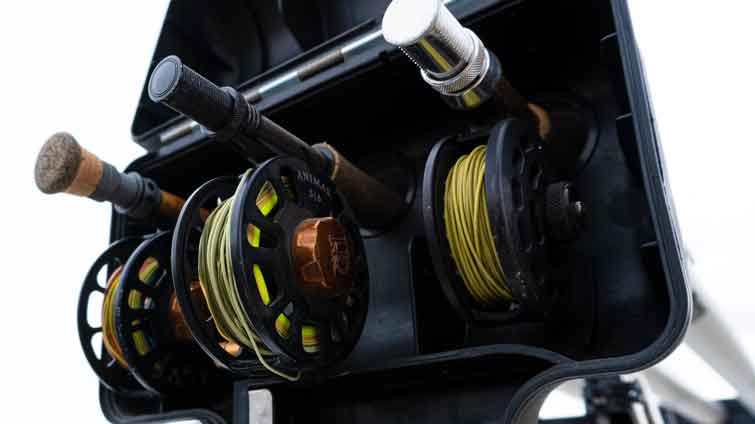Euro Nymphing is a technique that is growing in popularity worldwide. This can be done in various ways, but the most popular way to do it is with a fly rod and fly line. In order to get started in Euro Nymphing, you will need some basic gear.
As a general rule here are some of the gear you'll need for Euro Nymphing:
- A 10 to 11 foot 3 or 4 weight fly rod
- An ultra-lite euro nymph fly line
- Light tippet and a sighter
- Nymphs, a net, and waders

Euro Nymphing is a technique used by fly fishers to catch trout and other fish. It is similar to traditional nymphing but uses a weighted fly, an extended leader, and light tippets. In this article, we’ll look at what makes an ideal Euro Nymphing rod and what flies, lines, leaders, and more to use when Euro Nymphing.
What Is a Euro Rod?
A Euro rod is a fly rod that is designed for Euro Nymphing. This type of rod is longer than a traditional fly rod and has a softer action. This allows you to make delicate casts with more control.
Some characteristics that make an excellent Nymph fly rod include:
- 10 to 11 ft in length
- A 3 weight
- Slow action, and
- An ultra-lite Euro Nymph line
Euro Nymph rods are designed to cast very light flies with great accuracy. They are perfect for fishing in tight quarters and provide the angler with a lot of control over their presentation. The longer the rod is, the easier it is to drift at a long-distance naturally.

The Length of The Rod
Long Euro Nymph rods are designed to give you a lot of control and accuracy when presenting your fly. They are also great for fishing in tight quarters. The downside is that they can be harder to cast in windy conditions.
You'll need to consider a few characteristics when choosing the length of your specific rod, including:
- Your fishing distance - The wider the river you're fishing, the longer the rod should be. A nine-foot rod will work fine for smaller streams, but for wider bodies of water, you'll want at least an eleven-foot rod.
- Your casting ability - some people find it easier to cast a long rod, while others prefer a shorter rod.
- The size of the fish you're targeting - a smaller fish won't require as much force to fight against your line, so you can get away with using a lighter rod.
- Versatility - Consider if you need to use the rod during a different hatch. If so, shoot for a rod that can be used for multiple fishing styles.

The Weight of The Rod
A 3-weight rod is a perfect weight for Euro Nymph fishing. Newer Euro Nymphing rods have enough power to handle larger fish, but it’s still light enough to make accurate tuck casts easily. When Euro Nymphing, your rod should be light enough to easily hold it up for an extended period without feeling fatigued.
Euro Nymphing has multiple techniques that require your arm to be active all day. Therefore, a lightweight rod is beneficial to keep you on the water all day. Although your arm might be sore after a day of Euro Nymphing, it will hurt less with a Euro rod.
The Length of The Rod
A longer rod will help you with more accurate casts with the lightweight leader and tippet. However, not everyone prefers a long rod - some anglers find it challenging to make delicate fishing presentations like you would with a dry fly with a rod that is too long.

You could start with a 9 to 10-foot rod if you are new to Euro Nymphing. This will give you enough power to handle larger fish, but it's still light enough if you want to swap over to dry flies midday.
The reel is another important piece of gear when Euro Nymphing. Because a Euro rod is longer, you'll need a balanced reel with a larger diameter spool to even out the rod. You'll also want a reel with a smooth drag system that will allow you to fight big fish without breaking the line.
The Action of The Rod
A slow-action rod gives you more control over your presentation and makes it easier to place your fly where you want it delicately. While the rod's action is purely up to the fisherman's personal preference, a rod that has a slow action will have more trouble performing repetitive casts quickly, especially with heavy nymphs and windy conditions.

The usual size for a traditional Euro Nymphing leader is 10 to 12 feet when it comes to leaders, not including your sighter and tippet. It's not unusual to use a nymphing leader that is twice the length of the rod or even up 20 feet long if you enjoy the feel of mono in your hands versus fly line.
It would be best to utilize a straight piece of tippet material ranging from 4x-7x based on circumstances. The length may vary from 3 to 6ft or more depending on water depth and other factors.
How Do You Pick a Euro Nymphing Rod?
Euro Nymphing rods are more maneuverable than traditional trout rods. They also tend to have a softer feel, which can help you sense even the slightest bit of resistance from your line. Most Euro Nymphing rods are also longer, which gives anglers more leverage when making short, repetitive casts.
When selecting a Euro Nymphing rod, it's essential to consider the weight of the line you'll be using. A 3-weight rod is an excellent general-purpose option that will work well for small streams and larger rivers.

Euro Nymphing rods are all about control and reactivity, so you'll also want to choose a model that feels good in your hand. Pay attention to the weight and length of the rod.
What Weight Is a Euro Nymphing Rod?
Euro Nymphing rods are ultra-light to give the fisherman complete control of the nymphs they're fishing along the stream's bottom. Both inexpensive and expert choices are available, ranging from 10' to 11'6" in length.
The most popular Euro Nymphing rod weight is a 3. Euro Nymphing competition rods can be a 2, 3 or 4-weight. A 3-weight rod is an excellent general-purpose option that will work well for small streams and larger rivers.

The length of the Euro Nymphing rod also affects its control and reactivity. The shorter 10' models are more reactive and better suited for smaller streams. The 11'6" models offer more control and are better for larger rivers.
When deciding on the length you need, consider the size of the streams you'll be fishing and how much distance you'll need to cover between casts.
What Line, Leader, and Tippet Do You Use for Euro Nymphing?
When it comes to Euro Nymphing, the thinner and lighter your line, the better. Thin, light lines allow you to make exact presentations and give you greater feedback from your fly as it swims through the water. They also help the fly cut through the water to the feeding zone faster.
For Euro Nymphing, a 0-2 diameter monofilament line is ideal. These lines are a good option for Euro Nymphing, as they are incredibly thin and provide even more sensitivity than traditional fly lines.

Fluorocarbon is the finest option for tippet material because of its greater density, low refractive light index, and superior sink rate compared to other lines such as monofilament and copolymer tippets. Thin diameter tippet material is preferable; it goes through the water column more effectively.
Can You Euro Nymph With a Spinning Rod?
Spinning rods are not the ideal tool for Euro Nymphing, as they are designed for casting bait and lures. A spinning rod will not provide the level of sensitivity needed to feel the takes of a trout on a euro nymph rig.
It is possible to Euro Nymph with a spinning rod, but you'll need to add enough weight to your line. You can use a split shot or twist on lead for this purpose.

If you are tight on money or do not have an option for a fly rod, a spinning rod can be used for Euro Nymphing. You will have to be more selective with your fishing spots and adapt your techniques to work with the limitations of the spinning rod.
What Types of Flies Do I Use Euro Nymphing?
Flies with tungsten weights and light tippets are used to rapidly sink flies, with a "sighter" (a monofilament portion in multiple colors) ideal for Euro Nymphing. Euro nymphs will often have a slimmer profile and are fitted with a barbless jig hook.
As a general rule some of the best flies to use when Euro Nymphing are:
- Spanish Bullet
- Hardbody Perdigon jig
- Blowtorch tungsten
- The Frenchie
The flies you choose to Euro Nymph with will largely depend on the species of fish you are targeting and the water conditions you are fishing in. Heavier flies will work better in faster, deeper water, while smaller, more delicate flies will be more effective in slower, shallower water. It is important to experiment until you find a combination of flies that works well for your local streams and fish.

Euro Nymphing has gained in popularity in recent years as anglers have discovered the effectiveness of this technique for catching trout. While there are many different ways to rig up for Euro Nymphing, the key components are a long lightweight rod, a thin ultra-lite line, and a tippet.
Euro Nymphing is a great way to target fish feeding on the bottom of the stream. Using a weighted fly and a specialized line, you can quickly and efficiently present your fly to fish in even the most challenging water conditions.




